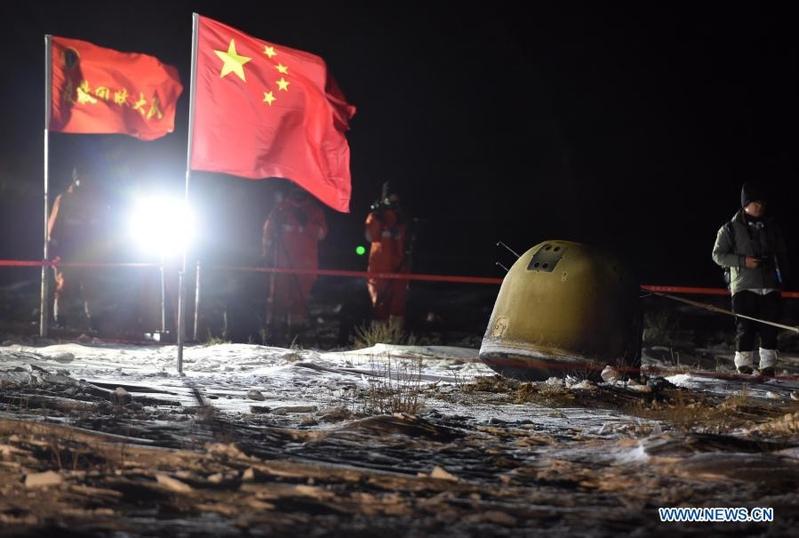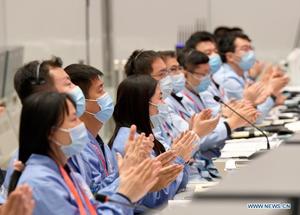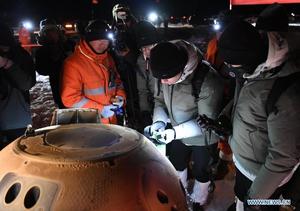 The return capsule of China's Chang'e-5 probe lands in Siziwang Banner, north China's Inner Mongolia Autonomous Region, on Dec 17, 2020. (REN JUNCHUAN / XINHUA)
The return capsule of China's Chang'e-5 probe lands in Siziwang Banner, north China's Inner Mongolia Autonomous Region, on Dec 17, 2020. (REN JUNCHUAN / XINHUA)
BEIJING - The return capsule of China's Chang'e-5 probe touched down on Earth in the early hours of Thursday, bringing back the country's first samples collected from the moon, as well as the world's freshest lunar samples in over 40 years.
The spacecraft landed in Siziwang Banner, north China's Inner Mongolia Autonomous Region, at 1:59 am (Beijing Time), according to the China National Space Administration (CNSA).
The spacecraft landed in Siziwang Banner, north China's Inner Mongolia Autonomous Region, at 1:59 am (Beijing Time), according to the China National Space Administration
Zhang Kejian, head of the CNSA, declared the Chang'e-5 mission a success. It marks a successful conclusion of China's current three-step lunar exploration program of orbiting and landing, and bringing back samples, which began in 2004.
ALSO READ: Chang'e-5 completes 2nd orbital correction en route to Earth
President Xi Jinping sent his congratulations for the complete success of the Chang'e-5 mission.
On behalf of the Communist Party of China (CPC) Central Committee, the State Council and the Central Military Commission (CMC), Xi, also general secretary of the CPC Central Committee and chairman of the CMC, extended warm congratulations and sincere greetings to all members who participated in the Chang'e-5 mission in a congratulatory message.
As China's most complicated space project, Xi said the Chang'e-5 mission has achieved the extraterrestrial sampling and returning for the first time. It is another major achievement in overcoming difficulties by giving full play to the advantages of the new system of pooling national resources and strength, marking a great step forward in China's space industry. This will contribute to deepening the understanding of the origin of the moon and the evolution history of the solar system, he noted.
"Your remarkable feats will always be remembered by our country and people," said Xi.
 This simulated image captured at Beijing Aerospace Control Center in Beijing, capital of China, Dec 17, 2020 shows the landing of the return capsule of China's Chang'e-5 probe. (JIN LIWANG / XINHUA)
This simulated image captured at Beijing Aerospace Control Center in Beijing, capital of China, Dec 17, 2020 shows the landing of the return capsule of China's Chang'e-5 probe. (JIN LIWANG / XINHUA)
Noting that there is no end for space exploration, Xi expressed the hope that those who have participated in the Chang'e-5 mission will carry forward the lunar exploration spirit of pursuing dreams, daring to explore, collaborating in tackling difficulties and win-win cooperation, and start new interplanetary exploration, so as to contribute to building China's strength in aerospace, achieving national rejuvenation, peaceful use of space and building of a community with a shared future for humanity.
ALSO READ: Chang'e-5 completes first orbital correction en route to Earth
The congratulatory message was read out by State Councilor Wang Yong at the Beijing Aerospace Control Center.
Under ground control, the return capsule separated from the orbiter about 5,000 km above the Atlantic. The capsule entered the Earth's atmosphere at an altitude of about 120 km and a speed of about 11.2 km per second at 1:33 am.
After aerodynamic deceleration, it skipped out of the atmosphere. Then the capsule re-entered the atmosphere to perform aerodynamic deceleration a second time. At about 10 km above ground, a parachute opened.
The capsule landed smoothly in the predetermined area, and the search team recovered it.
 Technical personnel celebrate the landing of the return capsule of China's Chang'e-5 probe at Beijing Aerospace Control Center in Beijing, capital of China, Dec 17, 2020. (YUE YUEWEI / XINHUA)
Technical personnel celebrate the landing of the return capsule of China's Chang'e-5 probe at Beijing Aerospace Control Center in Beijing, capital of China, Dec 17, 2020. (YUE YUEWEI / XINHUA)
The capsule is set to be airlifted to Beijing for opening, and the moon samples will be delivered to the research team for analysis and study, said the CNSA.
ALSO READ: China's Chang'e-5 completes sampling on moon
China will make some of the samples available to scientists in other countries, Pei Zhaoyu, deputy director of the Lunar Exploration and Space Program Center of CNSA, has said.
The probe, comprising an orbiter, a lander, an ascender and a returner, was launched on Nov 24, and its lander-ascender combination touched down on the north of the Mons Rumker in Oceanus Procellarum, also known as the Ocean of Storms, on the near side of the moon on Dec 1.
This site was chosen because it had a younger geological age than the sampling areas of the United States and the Soviet Union more than 40 years ago, and had never been sampled. The new samples will be of great scientific value, said researchers.
Though lunar samples were brought back in US and Soviet missions, scientists need more samples of different ages to piece together a complete history of the moon.
Chang'e-5 drilled into the lunar surface for samples that record evolutionary events, and grabbed material on the surface. Using modern analytical technologies, scientists will be able to unravel the mysteries of volcanic activities and meteorite impacts over the past billion years.
ALSO READ: Chang'e 5 embarks on journey to new frontier
The probe has collected material at different sites to ensure the diversity of the samples.
After the samples were sealed, the probe's ascender successfully took off from the moon and docked with the orbiter-returner combination in lunar orbit.
 Staff members work at the landing site of the return capsule of China's Chang'e-5 probe in Siziwang Banner, north China's Inner Mongolia Autonomous Region, on Dec 17, 2020. (LIAN ZHEN / XINHUA)
Staff members work at the landing site of the return capsule of China's Chang'e-5 probe in Siziwang Banner, north China's Inner Mongolia Autonomous Region, on Dec 17, 2020. (LIAN ZHEN / XINHUA)
The samples were transferred to the returner, before the ascender separated from the orbiter-returner. To avoid becoming space junk, the ascender made a controlled descent back to the moon, said the CNSA.
Then the orbiter-returner carried the precious samples home.
ALSO READ: Chang'e-5 'enters moon-Earth transfer orbit'
The milestone mission has accomplished several firsts for China, including the first moon sampling, the first liftoff from an extraterrestrial body, the first rendezvous and docking in lunar orbit, and the first spacecraft carrying samples to re-enter the Earth's atmosphere at high speed.
The Chang'e-5 mission laid a foundation for future manned lunar and deep space exploration. "China is drawing up plans for future lunar exploration, including constructing a basic version of a scientific research station," said Pei.
"We hope to cooperate with other countries to build the international lunar scientific research station, which could provide a shared platform for lunar scientific exploration and technological experiments," Pei said.
 Technical personnel monitor the landing of the return capsule of China's Chang'e-5 probe at Beijing Aerospace Control Center in Beijing, capital of China, Dec 17, 2020. (YUE YUEWEI / XINHUA)
Technical personnel monitor the landing of the return capsule of China's Chang'e-5 probe at Beijing Aerospace Control Center in Beijing, capital of China, Dec 17, 2020. (YUE YUEWEI / XINHUA)
International cooperation
China will invite more scientists around the world to join in moon research in a bid to achieve more scientific results, according to a CNSA official.
China plans to launch four manned spacecraft as part of its space station construction program in the next two years, said Wu Yanhua, vice administrator of the CNSA
China will solicit cooperation proposals extensively per the regulations on the management of lunar samples and data, said Wu Yanhua, vice administrator of the CNSA, Thursday at a press conference in Beijing.
In the Chang'e-5 mission, China coordinated and cooperated with countries and international organizations, including the European Space Agency, Argentina, Namibia, and Pakistan, in space tracking and control, Wu added.
Wu said China would implement multiple space missions, including Chang'e-6, Chang'e-7, Chang'e-8, asteroid exploration, Mars sampling returns, and Jupiter explorations in the future.
Wu also said that China is willing to cooperate with the United States on the scientific study of its new lunar samples, but whether such cooperation takes place depends on the policy of the US government.
Wu said China's manned space program will be very busy in 2021 and 2022 as the country plans to launch four manned spacecraft as part of its space station construction program in the next two years.
A total of 11 missions to build China's space station are planned for the next two years, including the construction of the core module that is scheduled to be launched in the first half of next year, two lab capsules, as well as four manned craft and four cargo craft.
A large number of in-orbit scientific experiments will then be carried out on China's space station, he added.


